Highlights from the 51st International Symposium on High Performance Liquid Phase Separations and Related Techniques (HPLC 2023)
The 51st International Symposium on High Performance Liquid Phase Separations and Related Techniques (HPLC 2023), chaired by Michael Lämmerhofer and Oliver Schmitz, was held from June 18 to 22 in Duesseldorf, Germany. This installment of “Column Watch” presents many of the highlighted topics and trends observed at this exceptionally well-run symposium.
The 51st International Symposium on High Performance Liquid Phase Separations and Related Techniques, or HPLC 2023, was held in Duesseldorf, Germany, and it was chaired by Michael Lämmerhofer (Tübingen) and Oliver J. Schmitz (Duisburg-Essen). The HPLC symposium continues to be the premier event bringing together leading scientists in liquid chromatography and related techniques. The conference was well organized, packed with an abundance of solid science, and provided for high-quality interactions with colleagues and friends.
In this installment of “Column Watch,” observed highlights and trends from the conference are reported. In a similar fashion to the previous HPLC symposium review articles (1–5), many colleagues in attendance at the symposium were asked for their insights regarding the most interesting topics they observed at the event. Figure 1 captures the major topics of interest as an infographic gleaned from these responses. What follows is a synopsis of these highlighted topics, along with some personal views and observations.
FIGURE 1: Highlighted topics of interest at HPLC 2023 as generated with Pro Word Cloud. (Image courtesy of the author).
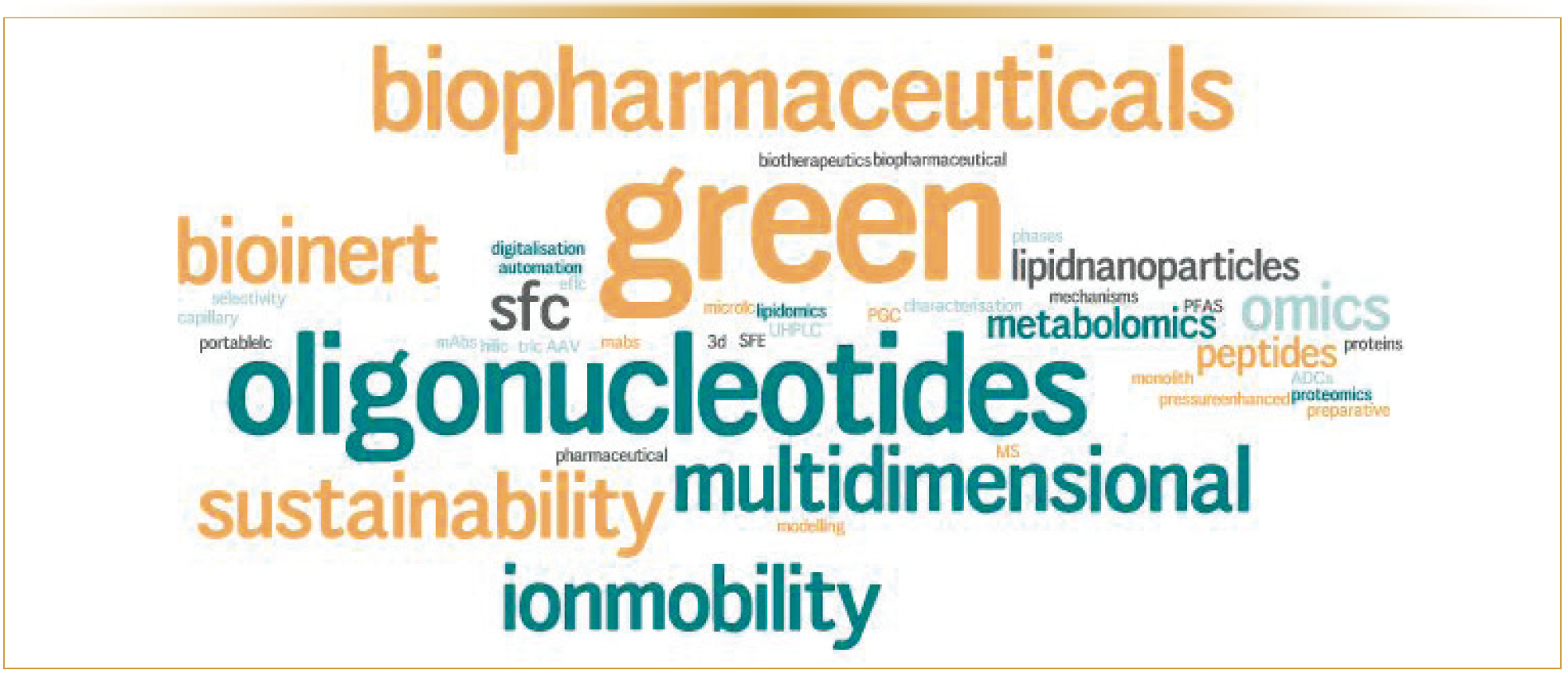
Biopharmaceutical and Oligonucleotide Drivers
The topic of biopharmaceuticals took a large share of the attention at HPLC 2023. Many talks discussed the importance of the high-performance liquid chromatography (HPLC) technique for biotherapeutics. Oligonucleotide separations, as with HPLC 2022, were again a dominant topic. In addition, many “omics” topics, such as proteomics, lipidomics, metabolomics, “multi-omics,” and even “valvomics” (which was discussed in Schoenmaker’s talk, “New LC Characterization Methods: What a (Few) Valve(s) Can Do”) were discussed. A few of the talks on the topic of biopharmaceuticals and related omics fields at the conference are discussed here.
The subject of biopharmaceuticals was immediately evident in an opening plenary lecture by John McLean (Vanderbilt University), where he introduced a new area of “omics” research, phenomics, or the systematic study of traits that make up a phenotype. One of the main challenges in this area of research is that many key markers of diseases are isomeric pairs, and thus require separation prior to mass spectrometric detection. McLean also noted another dominant topic of the conference when he discussed the use of ion mobility in conjunction with liquid chromatography-mass spectrometry (LC–MS; see additional information on ion mobility in subsequent sections). The technique was used by the researchers to examine lipids and other drug metabolites in organ-on-a-chip models. In one striking demonstration of the technique, the researchers detected biomarker changes to the system almost immediately after a liver model was dosed with acetaminophen.
In a highly touted lecture, Robert Kennedy (University of Michigan) discussed his group’s quest to push HPLC efficiency and throughput to new levels. Kennedy demonstrated excellent peak capacity for a metabolomics sample with a 50-cm long column packed with 1.7 μm particles; however, this generated a backpressure of 35k psi, which is beyond the limits of commercial ultrahigh-pressure liquid chromatography (UHPLC) systems. Working with Waters Corporation, Kennedy employed novel 1.1 μm particles, which led to comparable efficiency but only required a 20 cm column. This novel particle technology was then demonstrated with a 2D-LC–MS (hydrophilic interaction chromatography [HILIC] × reversed-phase liquid chromatography [RPLC]) lipidomics assay where a peak capacity of 1900 was achieved in 60 min.
Govert Somsen (Vrije Universiteit Amsterdam) presented strategies to improve sensitivity and MS-compatibility for native, size-based separations of proteins. Utilizing a 1.0-mm internal diameter (i.d.) size-exclusion chromatography (SEC) column at low flow rates resulted in a 12–16-fold increase in sensitivity for various proteins over conventional 2.1-mm i.d. columns. By utilizing this low flow rate, ion suppression at the source was minimized, which also allowed the researchers to use higher concentrations of volatile salts (600 mM ammonium acetate) to further prevent protein–stationary phase interactions. This strategy was used to analyze the asparaginase enzyme without the loss of the protein’s quaternary structure.
Christian Hubert (University of Salzburg) presented his group’s work on developing a platform of chromatographic methods in fully characterizing protein glycoforms. Utilizing a combination of a nano porous graphitic carbon (PGC) column, a nano C18 column, and native MS combined with anion-exchange chromatography, the researchers were able to discover and resolve more than 42k glycoforms of myozyme, as in one application example. Comparison of innovator versus biosimilar therapeutics using this platform approach also led to significant differences in the glyco profile of the two drugs which could not be elucidated using conventional approaches.
Davy Guillarme (University of Geneva) presented a compelling case for using ultra-short columns for analyzing protein biotherapeutics. Proteins are known for their on/off adsorption mechanism in RPLC. Theory predicts that proteins are infinitely retained at the column inlet (on or near the frit), and they are only released after a certain concentration of organic is entered into the flow path. To test this theory, Guillarme and collaborators from Waters developed columns with lengths from 2–20 mm packed with RPLC, HILIC, and ion exchange (IEX) particles. Indeed, comparable efficiencies were achieved with these ultra-short columns as could be achieved with conventional 5–15 cm length columns, but with analysis times in the order of seconds. Select applications included peptide mapping of National Institute of Standards and Technology (NIST) monoclonal antibodies (mAb) in less than 30 s and the calculation of the drug-to-antibody ratio of an antibody drug conjugate (ADC) in 24 s. Guillarme concluded the talk saying that as good as these columns are, their performance could be even better if instruments are redesigned to significantly reduce post-column path length to the detector as band broadening does occur.
As has been the case for more than a decade, biopharmaceutical needs are a major driver for HPLC innovations. The few talks mentioned above demonstrate that this industry is poised to continue to provide challenges that promote further developments in all aspects of analytical chemistry, including separation science.
Green and Sustainable Analytical Chemistry
At HPLC 2022, it was noted that green and sustainable analytical chemistry was fast becoming a dominant topic of interest (5). That trend continued at HPLC 2023, with an even greater presence as demonstrated by the number of talks focused on developments in this area. Elia Psillakis (University of Crete) provided an excellent recount of the recent history of developments in understanding the goals and systems to measure “greenness” and sustainability of analytical methods. A crucial point made in this presentation was that an additional condition of a green method on top of the more obvious attributes is to reduce or eliminate waste. Psillakis noted that the complete definition of what “green” or “sustainable” means is still actively under development.
Tadeusz Gorecki (University of Waterloo) also discussed different measurements used to assess how green an analytical procedure is by taking a step back from the methodology itself and looking at the entire process. Alternative renewable and less toxic solvents usage was also discussed.
A couple of talks, including one from Martina Catani (University of Ferrara) and another from myself (Restek Corporation, LCGC North America), discussed research probing for suitable “greener” alternative solvents for use in chromatography. While Catani focused on linear and preparative RPLC systems, my focus was on attempting to replace acetonitrile in HILIC systems. Catani reported promising results substituting dimethyl carbamate for common, less green solvents, such as acetonitrile and methanol. Although acetonitrile still reigns supreme for HILIC, as this author’s work suggests, more environmentally suitable and sustainable solvents, such as ethanol and ethyl lactate, may be substituted in certain cases. It is clear from both talks that much more research is required to achieve green and sustainable methods while maintaining the necessary qualities of the overall separation achieved.
The direct substitution of green solvents for traditionally used “less green” solvents is only one means of lowering the impact of current analytical methods. Frederic Lynen (Ghent University) presented on a unique mode of chromatography: temperature-responsive liquid chromatography (TRLC), which can eliminate the use of organic solvents in the mobile phase. Using thermal-responsive polymers, Lynen developed stationary phases that could change their degree of hydrophobicity based on the temperature of the column. No organic solvent is required to elute analytes from the column, making this approach a green alternative to typical RPLC. For more detailed information on TRLC, please see two recent articles on the subject (6,7).
Employing alternative techniques such as supercritical fluid chromatography (SFC), reducing consumption through microsampling or HPLC miniaturization, and using in silico modeling to reduce experimental waste, are all additional areas of active exploration toward greener methods. The quest for green and sustainable analytical methods is, and will continue to be, a significant driver for HPLC innovation for the foreseeable future.
Multidimensional LC and Ion-Mobility
Multidimensional liquid chromatography (MDLC) has been increasingly prominent at recent HPLC meetings. This year, there were three full sessions dedicated to the topic, indicating the trend is continuing. As noted in a talk by Dwight Stoll (Gustavus Adolphus College and the ChromSoc Silver Medal Jubilee 2021 awardee), scientists have been conducting heart-cutting two-dimensional liquid chromatography (2D-LC) for approximately 45 years. More sophisticated concepts, such as multiple heartcutting 2D-LC (mLC-LC) and selective comprehensive 2D-LC (sLC-LC), are more recent (circa 2010). These latter techniques have become popular modes, and they have thus prompted the introduction of commercial hardware and software to support them. In addition, quantitation strategies and data analysis tools have been defined and refined to meet the needs of noncomprehensive 2D-LC. Stoll stressed that what is required now are tools and strategies for method development in this arena, which is where his group is now focusing. Figure 2 from Stoll’s presentation nicely depicts the past, current state, and future of this exciting field.
FIGURE 2: Depiction of the current status of non-comprehensive 2D-LC: Where does the 2D-LC field stand today? (Image courtesy of Dwight Stoll [Gustavus Adolphus College])
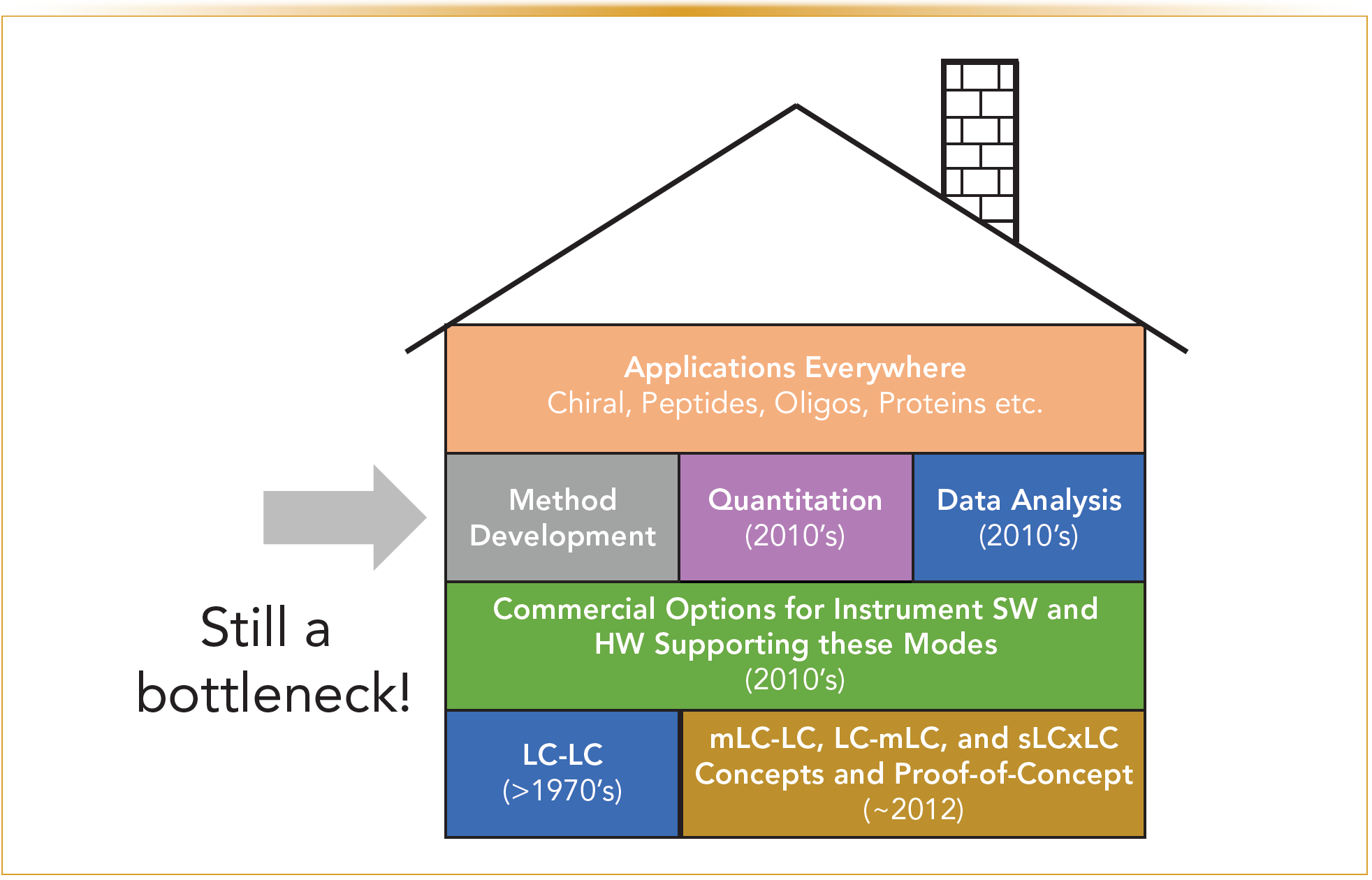
André de Villiers (Stellenbosch University) provided a similar message noting that automated method development for 2D-LC is needed because of the complex, often counterintuitive nature of the process, and that the task is complex because of the need to accommodate the interplay between many variables. He went on to note that, although the algorithms are complex, development is possible, and the results are useful. Limitations such as the shortcoming of theoretical models to model injection band broadening in the second dimension, and the need for experimental measurement of analyte/separation/system parameters were noted; however, experimental verification of the predicted separations obtained using the software is extremely promising in terms of accuracy. de Villiers demonstrated this using HILIC × RPLC and RPLC × HILIC separation of phenolic compounds.
Koen Sandra (RIC Group and Ghent University) presented an excellent talk on further understanding the structure/function relationship of therapeutic antibodies. In this study, Sandra utilized novel affinity columns in 2D-LC coupled to mass spectrometry (2D-LC–MS) assays, relying on specific antibody binding interactions, to interrogate the antibody-dependent cellular cytotoxicity (ADCC) of the biotherapeutics. Using this technique, Sandra resolved oxidized variants from main antibody peaks, which provided circumstantial evidence for lower therapeutic efficacy. In an alternative approach, Sandra used capillary electrophoresis coupled to MS and middle and bottom-up digestion to further gauge primary structure of the therapeutics. Sandra and colleagues discovered key point mutations (cysteine to tyrosine substitution) in the mAb.
Ion mobility–mass spectrometry (IM–MS) was also a prominent technique at the symposium, with two sessions dedicated specifically to it, as well as utilization in research discussed outside these sessions. Valerie Gabelica (University of Bordeaux) gave an interesting plenary talk on using ion mobility–mass spectrometry to elucidate biopolymer folding and interactions. Gabelica used IM–MS, along with super-charging agents (salts that shift spectra to higher charge states) to get more accurate mass spectra of proteins. The researchers could elucidate folded, unfolded, and partially folded proteins by using this technique. IM–MS was first noted as a highlight at the HPLC 2016 meeting (8); however, there seemed to be a significant increase in the attention given to the technique this year. Although the reason for this is unclear, improvements in IM–MS instrumentation and improved understanding of the structural information the technique offers may be contributing to the trend.
Bioinert
The topic of bioinert or metal-passivated systems and columns was highly prevalent at HPLC 2023. As noted in the LCGC 2022 review of new liquid chromatography columns and accessories column (9), system hardware with various metal passivation strategies has been on the rise recently. This trend continued into HPLC 2023 with several talks and posters highlighting bioinert systems and columns. Biopharmaceutical and specifically oligonucleotide applications dominated applications, but other areas such as environmental, food, and metabolomics are utilizing modern technology as well. In terms of new offerings from column vendors and instrument manufacturers, new stationary phases and systems that offer some form of bioinert sample pathway were the most prevalent at the meeting.
Other Observations and Conference Highlights
Poster Flash Presentations
Posters sessions contribute significantly to the HPLC program year after year. Unfortunately, because of other commitments and the fast-paced schedule this year, I was personally unable to spend much time within poster sessions. Fortunately, there were two poster flash sessions where authors of committee-selected posters were provided the opportunity to present five-minute lectures to the audience. The quality of the work and the presentations made in these sessions was one of my personal highlights, and one of the most noted events by colleagues at the conference. One colleague said the quality of the talks in this session was at the level of or surpassing those in other organized sessions.
Separation Science Slam and HPLC Tube
The Separation Science Slam and HPLC Tube events, originating at the 2019 HPLC meeting in Milan (3), were again a big hit at HPLC 2023. Both events provide a fun and engaging means of delivering scientific information, as well as showing off “other talents” our scientific community members possess. Based on the number of positive mentions, the events have established good traction, and will hopefully be continued in some fashion at future meetings.
In Memory of Andrew Alpert
Andy Alpert, often regarded as the “Father of HILIC,” sadly passed prior to the HPLC meeting this year. His contributions and enthusiasm were, however, very present. Hydrophilic interaction liquid chromatography or HILIC, as coined by Alpert, was again a major topic of discussion during the meeting, and his impact on science, as well as on the professional and personal lives of others was noted by several speakers. He will be missed.
Conclusions
The HPLC 2023 symposium, in its first return to Europe since 2019, was well organized, packed with great science, and highly engaging. Biopharmaceutical and especially oligonucleotide analysis needs are continuing to drive innovation in separation science and expanding the application of liquid separations to solve crucial challenges. Green and sustainable concerns are emerging as, perhaps, the next major innovation producer. Multidimensional liquid chromatography continues to make strides toward more routine analysis, and the attention paid to ion mobility coupled to liquid chromatography reminds us of the importance hyphenated techniques such as mass spectrometry plays in the development of separation tools. Product development from both column and system manufacturers has largely focused on providing inert sample pathways. It was noted in last year’s HPLC meeting review that our scientific community is awaiting that next revolutionary discovery. Although this revolution was not readily apparent from HPLC 2023, the inspiration for it just may have been seeded as a result of it.
The next HPLC meeting will be in Denver, Colorado, from July 20–25, 2024.
Acknowledgments
Coverage of such a large symposium is impossible without a great amount of assistance. The author would like to acknowledge the invaluable input and discussion from Professor Steven Ray Haakon Wilson, Professor Martina Catani, Professor Alla Chernobrovkina, Dr. Adrian Clarke, Professor James Grinias, Dr. Xiaoli Wang, Dr. Diego Lopez, Dr. Jesse Bischof, Dr. Jason Anspach, Dr. Tom Walter, Dr. Paul Jacobs, Dr. Mark Woodruff, Professor Dwight Stoll, Professor André de Villiers, and Professor Gert Desmet for providing notes, text, insights, figures, and enlightening discussions regarding the content of various sessions. The author would like to especially thank Mr. Cory Muraco for his incredibly valuable and highly detailed notes.
References
(1) Bell, D. S. Highlights from HPLC 2017 Symposium. LCGC Europe 2017, 30 (9), 496–504.
(2) Bell, D. S. Highlights from HPLC 2016. LCGC Europe 2016, 29 (9), 506–515.
(3) Bell, D. S. Highlights from the HPLC 2019 Symposium. LCGC North Am. 2019, 37 (10), 732–739.
(4) Bell, D. S.; Muraco, C. E.; Flannery, C. Highlights from the HPLC 2018 Symposium. LCGC North Am. 2018, 36 (10), 736–743.
(5) Muraco, C. E.; Bell, D. S. Highlights from the 50th International Symposium on High Performance Liquid Phase Separations and Related Techniques (HPLC 2022). LCGC North Am. 2022, 40 (9), 417–423. DOI: 10.56530/lcgc.na.ws5783s4
(6) Lynen, F.; Ampe, A.; Bandini, E.; et al. Perspectives in Hydrophobic Interaction Temperature-Responsive Liquid Chromatography (TRLC). LCGC North Am. 2022, 40 (12), 566–572. DOI: 10.56530/lcgc.na.vd2373d8
(7) Wicht, K.; Baert, M.; Schipperges, S.; et al. Enhanced Sensitivity in Comprehensive Liquid Chromatography: Overcoming the Dilution Problem in LC×LC via Temperature-Responsive Liquid Chromatography. Anal. Chem. 2022, 94 (48), 16728–16737. DOI: 10.1021/acs.analchem.2c03300
(8) Bell, D. S. Highlights from HPLC 2016. LCGC North Am. 2016, 34 (9), 700–709.
(9) Bell, D. S. New Liquid Chromatography Columns and Accessories in 2022. LCGC North Am. 2022, 40 (5), 210–215. DOI: 10.56530/lcgc.na.sx2967r4
ABOUT THE AUTHOR
David S. Bell is a Research Fellow in Research and Development at Restek. He also serves on the Editorial Advisory Board for LCGC and is the Editor for “Column Watch.” Over the past 20 years, he has worked directly in the chromatography industry, focusing his efforts on the design, development, and application of chromatographic stationary phases to advance gas chromatography, liquid chromatography, and related hyphenated techniques. His main objectives have been to create and promote novel separation technologies and to conduct research on molecular interactions that contribute to retention and selectivity in an array of chromatographic processes. His research results have been presented in symposia worldwide, and have resulted in numerous peer-reviewed journal and trade magazine articles. Direct correspondence to: LCGCedit@mmhgroup.com.
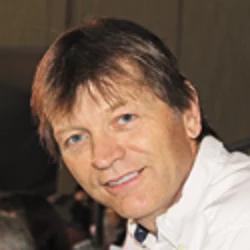
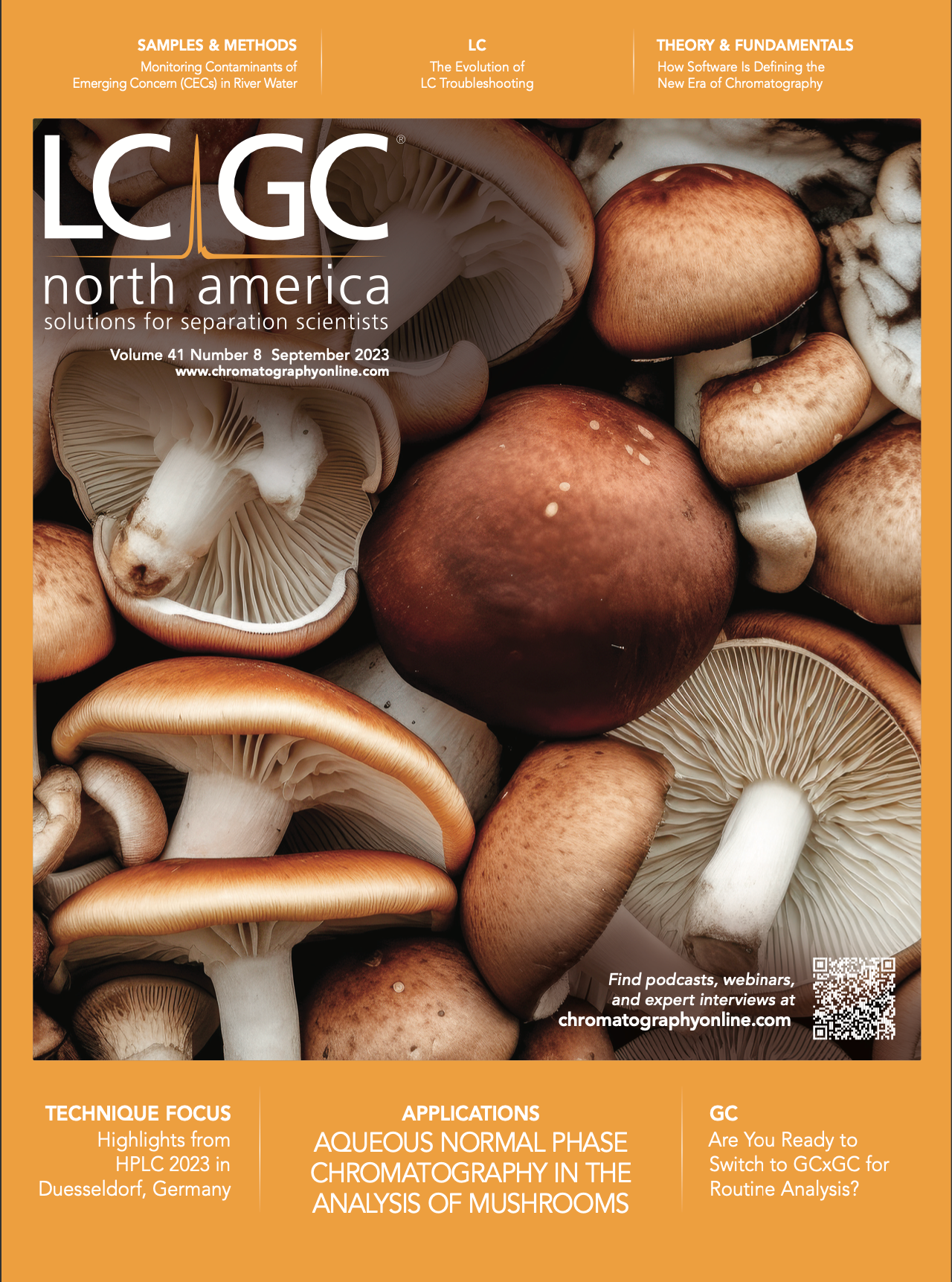


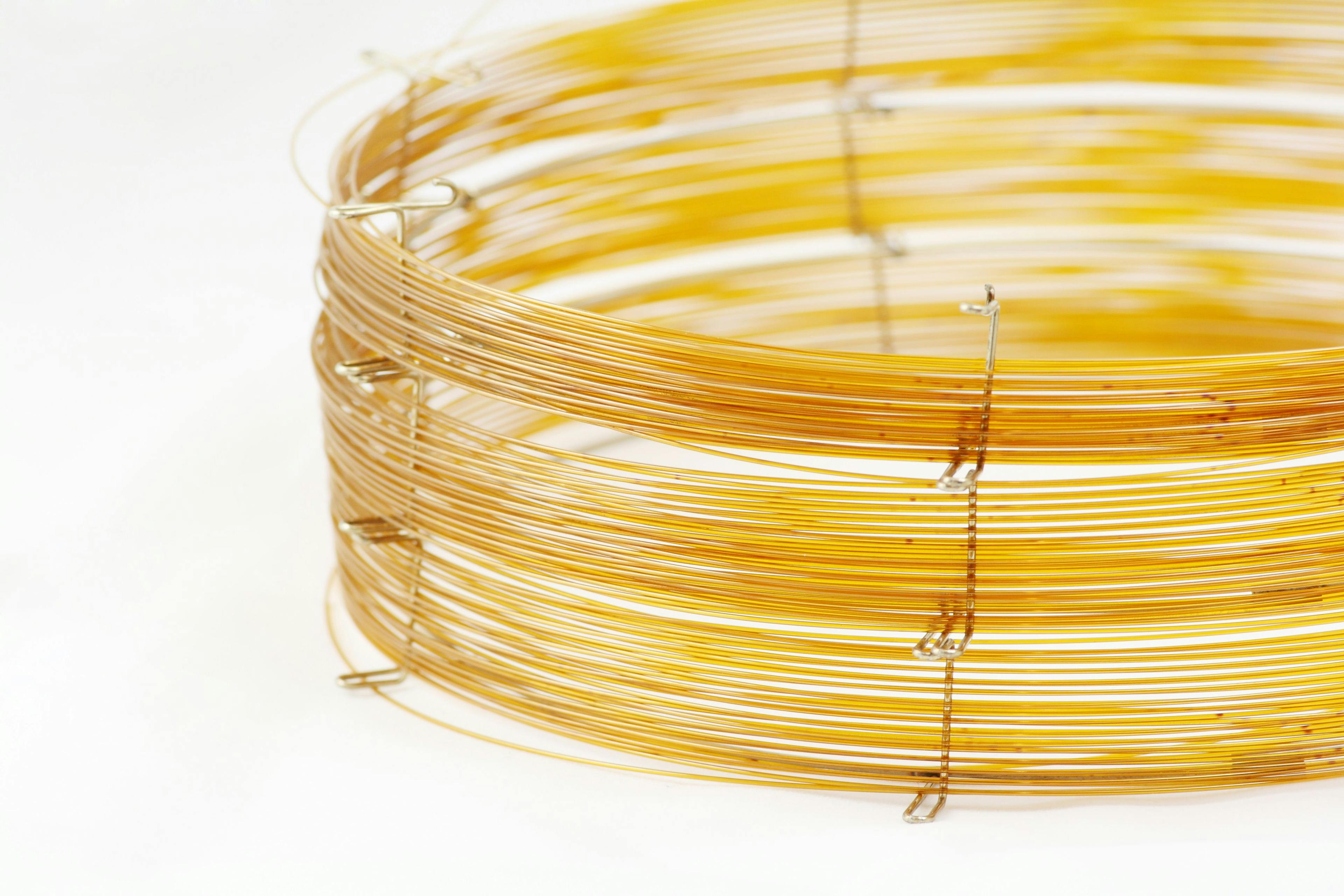
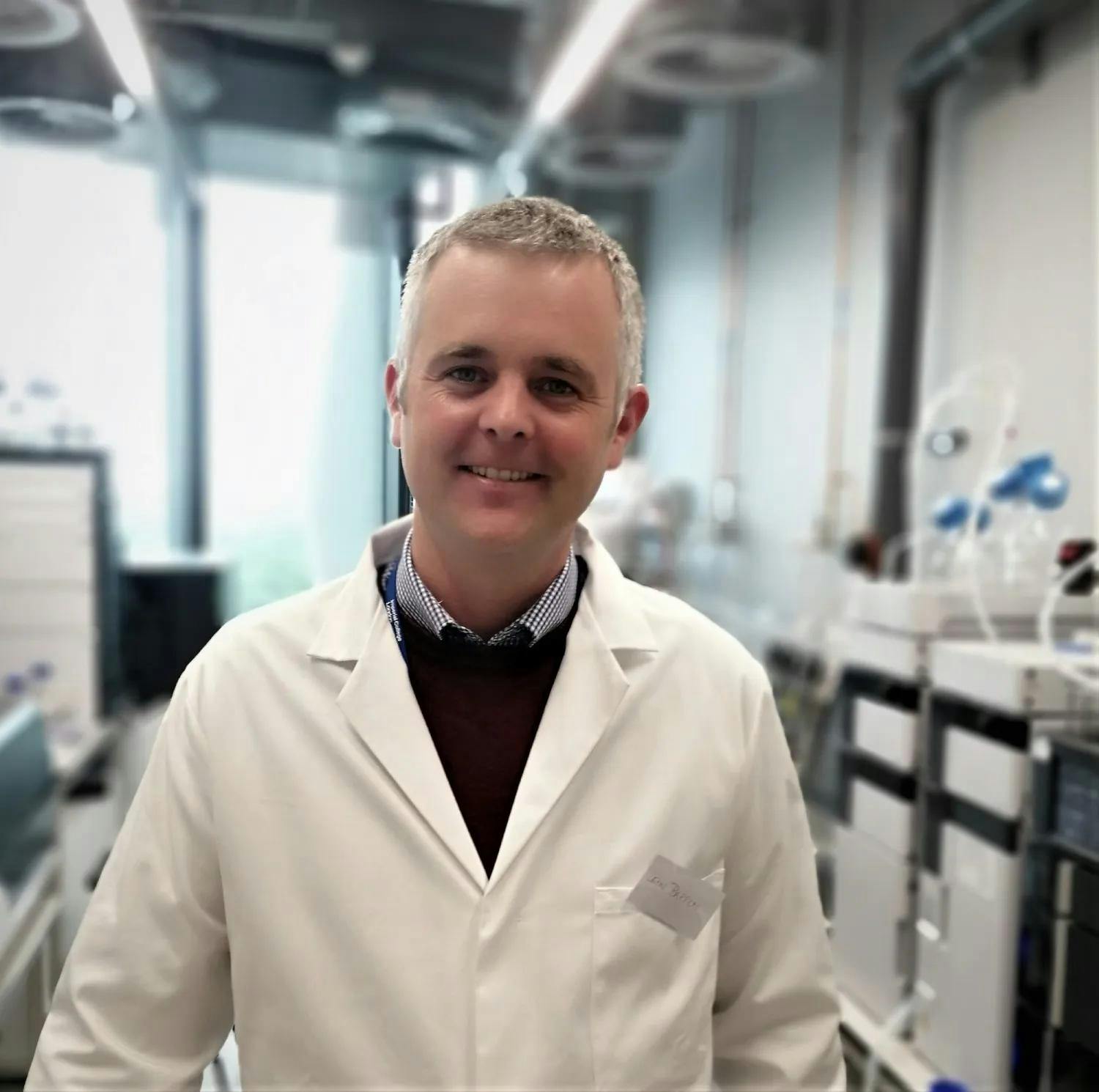














New Study Reviews Chromatography Methods for Flavonoid Analysis
April 21st 2025Flavonoids are widely used metabolites that carry out various functions in different industries, such as food and cosmetics. Detecting, separating, and quantifying them in fruit species can be a complicated process.
New Study Reviews Chromatography Methods for Flavonoid Analysis
April 21st 2025Flavonoids are widely used metabolites that carry out various functions in different industries, such as food and cosmetics. Detecting, separating, and quantifying them in fruit species can be a complicated process.
